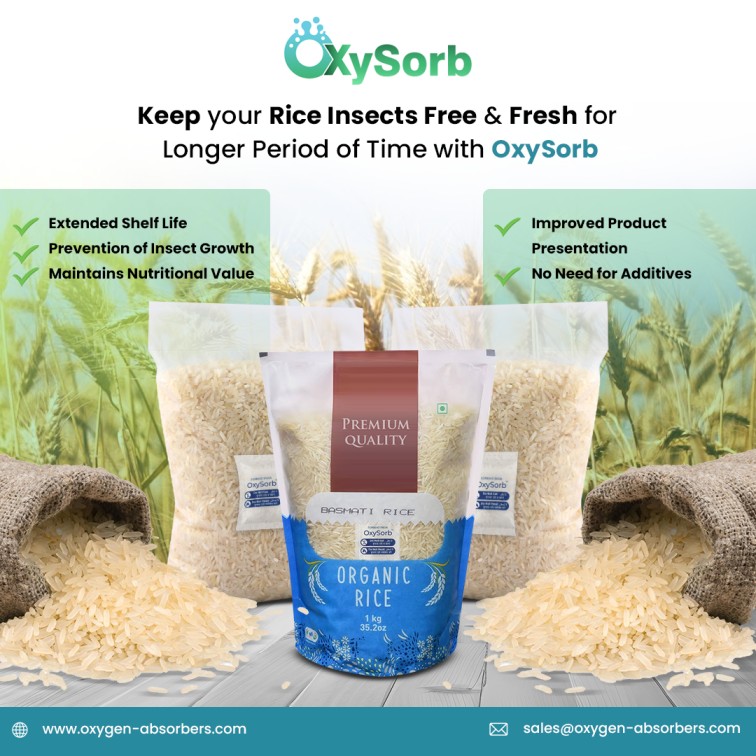So, you must be wondering, how to keep spices fresh for a longer time easily and efficiently, without the use of any chemicals, or altering products. Oxygen absorbers are an effective solution for this and can effectively keep spices dry and fresh for longer. These small packets contain iron powder that absorbs oxygen from the air. This creates an oxygen-free environment that slows down the oxidation process, which is the main cause of spice deterioration.
The presence of excess moisture and oxygen during packaging and storing of spices can lead to a lot of damage to the texture, freshness, quality, flavor, and structure of the various spices, may they be powdered or their whole form.
Oxygen is a reactive gas that can break down the molecules in spices, causing them to lose their flavor and aroma. By removing oxygen from the container, Oxysorb helps to protect spices from this process. In addition to removing excess oxygen from the surrounding air and environment, oxygen absorbers also absorb moisture from the air. This helps to prevent spices from becoming clumpy and moldy leading to deterioration and damage to their potency.
How to use oxygen absorbers to keep spices fresh longer?
Spices are highly sensitive to moisture, heat, and light, and oxygen is also a major contributor to spice degradation. When spices are exposed to oxygen, they can lose their flavor, aroma, and color, thus using Oxysorb can help to protect spices from these elements and extend their shelf life.
To use oxygen absorbers for spices, make sure you have your spices ready to be packaged or stored, proper suitable airtight storage containers, and the appropriate quantity of oxygen absorber packets. You can choose containers that are clean, dry, and made of materials that provide an effective barrier against moisture and air.
Before you begin the process of effective storage of spices, you need to examine your spices for any signs of moisture or clumping. Clumping may show that there is some amount of moisture that is present in the storage of spices, thus it is essential to remove it before it starts deteriorating. Dry spices are more effective in retaining their original flavor and potency.
Check the instructions on the oxygen absorbers you will be using to determine the correct dose for your spice amount. It is important not to overdose as this can lead to an oxygen-depleting environment in your spice storage setting, which can affect the quality of the spices you are using.
Place the required number of Oxysorb packets into each storage container before adding the spices to them. Oxygen absorbers work by removing the oxygen content from the enclosed container space, so it is essential to seal the container quickly and in an airtight manner after inserting the absorbers to maximize their effectiveness and retain their freshness and potency.
Once you have added the oxygen absorbers, close the containers to seal them with an airtight seal. This step is important because it stops oxygen and moisture from reentering of oxygen and moisture, both of which contribute to spice deterioration and spoilage.
Find a cool, dark place to store your spice containers, as excess exposure to light and heat can lead to a faster degradation process, so choose a storage place away from direct sunlight and heat, like a pantry or cupboard.
You need to periodically and frequently check your spice containers for any signs of moisture, clumping, or changes in color, texture, and taste. If you notice any issues, consider replacing the oxygen absorbers, as they may have got saturated, and ensuring the containers are properly sealed.
Tips to choose the right oxygen absorber for your spice storage
- Measure the size of your airtight spice container accurately. This will give you a proper idea for choosing the right absorber size.
- There are various types of oxygen absorbers available, each designed for a specific purpose and use. The most common type is iron-based absorbers, which are suitable for dry goods like spices, and silica gel absorbers, which are effective in adsorbing both oxygen and moisture. Choose a type that is best suitable for your preservation goals.
- Weigh or measure the amount of spices you intend to store in the container. This will help determine the absorbency capacity required.
- You can refer to the sizing chart provided by the oxygen absorber manufacturer, which will typically list the recommended absorber size based on container volume and spice quantity.
- Make sure you are only using food-grade and food-safe oxygen absorbers so that they do not alter or damage the spices. These varieties are usually non-toxic in nature and are safe to use with food products.
- Make sure to buy and source the oxygen absorbers from reputable suppliers or brands known for producing high-quality preservation products. This will ensure you are buying the best quality to be used that is made with food-safe materials.
- Check the expiration date or shelf life of the oxygen absorbers, as using expired absorbers may compromise their effectiveness and ability to effectively absorb moisture and oxygen in your storage setting.
- Ensure that the oxygen absorbers are individually sealed in airtight packaging until use. This helps to prevent premature activation of the absorbers and makes them more effective when placed in your spice storage containers.
- If you plan to store the spices for over a year or longer periods of time, consider using a larger size of absorber packet to ensure adequate oxygen absorption throughout the extended storage period.
Oxygen absorbers are a simple and effective way to extend the shelf life of your spices, so be sure to use them to package and store your spices for longer periods of time in their best form and potency.













